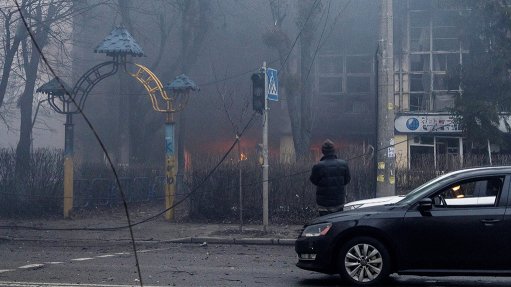R4bn more will set South Deep up for 50 years – Gold Fields

Gold Fields CEO Nick Holland tells Mining Weekly Online’s Martin Creamer that the finishing line is in sight for a South Deep that will produce at a rate of 700 000 oz of gold a year for the next 50 years. Camera Work and Video Editing: Darlene Creamer.
JOHANNESBURG (miningweekly.com) – The planned investment of R4-billion more in the giant South Deep gold project will set the mine up for 50 to 60 years of ongoing operation, Gold Fields CEO Nick Holland says.
The fully mechanised 3 500-employee South Deep is the only remaining South African asset of Gold Fields after the hive off of the Kloof, Driefontein and Beatrix gold mines to Sibanye Gold.
To date, the JSE- and NYSE-listed Gold Fields has invested R36-billion in South Deep, the company’s flagship growth project, situated 45 km south-west of Johannesburg, in Gauteng, the province of gold.
Its production build-up is on track to deliver 700 000 oz of gold a year from 2016, and then continue at that approximate output level to 2065 and beyond.
“We’re now over the hump of capital,” Holland tells Mining Weekly Online in a video interview (see attached).
The company spent R2.5-billion in 2012 and will spend R1.9-billion in 2013.
In 2014, capex is expected to drop to R1.5-billion, after which the operation will be in steady state.
Destressing, which involves creating criss-cross development through the orebody to allow the large open cavities to be mined without major geotechnical hitches, increased by 75% in 2012 and “if we get another big destress pick-up this year, we’ll be in good shape”, says Holland.
Destressing allows mining to take place at depth with lower rock pressures of 50 MPa rather that 500 MPa, which is the key to opening up the orebody.
All required infrastructure is in, including full hoisting capacity and a new backfill plant, which will provide the material needed to refill the mined-out voids with a mixture of tailings and cement.
Underground cooling capacity has been installed and the required electricity reticulation has been laid on.
“We’re in great shape. We can see the finishing line,” Holland adds to Mining Weekly Online.
South Deep’s orebody dips only 8 ° to 10 ° compared with most other South African orebodies that dip some 35 °.
The reef packages extend from 10 m to 200 m, with Gold Fields opting to mine only preferential cuts in the high-grade sections.
Large drill rigs, trucks and loaders engage in mechanised bulk mining 3 000 m below surface on a plane that is virtually horizontal.
By contrast, South Africa’s typical narrow-reefs are only one to three metres thick rendering mechanisation difficult.
Gold Fields will benchmark the performance of its South Deep operation against its mechanised mines in Australia and independent consulting engineers are engaged to conduct benchmark exercises.
In October, Gold Fields managed to clinch a worker-management agreement at South Deep with the National Union of Mineworkers on the implementation of a new operating model that will see the creation of 400 more jobs and the introduction of full calendar operations (Fulco), which have proved elusive in South African mining.
“That’s one of the reasons we moved to 24/7 because that’s the model that is typically employed in underground mechanised mines the world over,” Holland points out.
With Fulco, Gold Fields is hoping to elevate South Deep's performance to global best-practice levels, in the tall orebody.
By May, Holland expects the benefits of Fulco to start coming through.
“We’re very keen to make sure that we deliver the inherent quality of the orebody,” he adds to Mining Weekly Online.
The first year of 700 000 oz yearly output is scheduled to be 2016.
The new agreement, which cost South Deep R170-million in advance, is expected to define South Deep’s future as a modern producer with a bonus system that links employees to business objectives.
The upshot of the agreement is that South Deep will benefit from five more working hours a day – a 25% improvement – and seven more production days a year, while employees will average 50 fewer working days a year.
The mine employs less than half the number of people that a similarly sized conventional deep-level South African gold mine employs, with one high-performing drill rig operator I spoke to able to take home R50 000 a month.
Underground operational personnel in specific job categories have agreed to revert to a new rotation shift structure of four days on, four days off, four nights on, four nights off, in 12-hour shifts, referred to as 4x4.
The current Christmas breaks agreement have been eliminated, with the mine shutting down for eight days on December 23 each year and providing an effective 12-day Christmas break for each Fulco employee.
A comprehensive fatigue management system will be introduced to provide for a one-hour mid-shift food-and-drinks break, in addition to the food and drinks given out at the start of the shift.
The existing bonus schemes for underground employees are being replaced by a new, uncapped productivity-linked bonus scheme that will provide incentives for improved performance.
An independent expert has been appointed to verify a new grading system, which will take into account the nature of the work performed and create appropriate career paths.
Following the unbundling, Gold Fields’ production from South Africa is down to 13% of its total production from 48% before.
South Deep is being structured to advance the operation to a break-even position in the second half of 2013, which was significant for the ‘new Gold Fields’, which no longer had the significant cash generation from the other assets.
The JSE- and NYSE-listed Gold Fields Limited had net earnings of R546-million in the December quarter compared with R1 424-million in the September quarter and R2 605-million in the December 2011 quarter.
Net earnings from continuing operations for the December quarter amounted to R382-million compared with R1 000-million in the September quarter and R1 467-million in the December 2011 quarter.
Net earnings from discontinued operations for the December quarter amounted to R164-million compared with R425-million in the September quarter and R1 138-million in the December 2011 quarter.
Comments
Press Office
Announcements
What's On
Subscribe to improve your user experience...
Option 1 (equivalent of R125 a month):
Receive a weekly copy of Creamer Media's Engineering News & Mining Weekly magazine
(print copy for those in South Africa and e-magazine for those outside of South Africa)
Receive daily email newsletters
Access to full search results
Access archive of magazine back copies
Access to Projects in Progress
Access to ONE Research Report of your choice in PDF format
Option 2 (equivalent of R375 a month):
All benefits from Option 1
PLUS
Access to Creamer Media's Research Channel Africa for ALL Research Reports, in PDF format, on various industrial and mining sectors
including Electricity; Water; Energy Transition; Hydrogen; Roads, Rail and Ports; Coal; Gold; Platinum; Battery Metals; etc.
Already a subscriber?
Forgotten your password?
Receive weekly copy of Creamer Media's Engineering News & Mining Weekly magazine (print copy for those in South Africa and e-magazine for those outside of South Africa)
➕
Recieve daily email newsletters
➕
Access to full search results
➕
Access archive of magazine back copies
➕
Access to Projects in Progress
➕
Access to ONE Research Report of your choice in PDF format
RESEARCH CHANNEL AFRICA
R4500 (equivalent of R375 a month)
SUBSCRIBEAll benefits from Option 1
➕
Access to Creamer Media's Research Channel Africa for ALL Research Reports on various industrial and mining sectors, in PDF format, including on:
Electricity
➕
Water
➕
Energy Transition
➕
Hydrogen
➕
Roads, Rail and Ports
➕
Coal
➕
Gold
➕
Platinum
➕
Battery Metals
➕
etc.
Receive all benefits from Option 1 or Option 2 delivered to numerous people at your company
➕
Multiple User names and Passwords for simultaneous log-ins
➕
Intranet integration access to all in your organisation



















